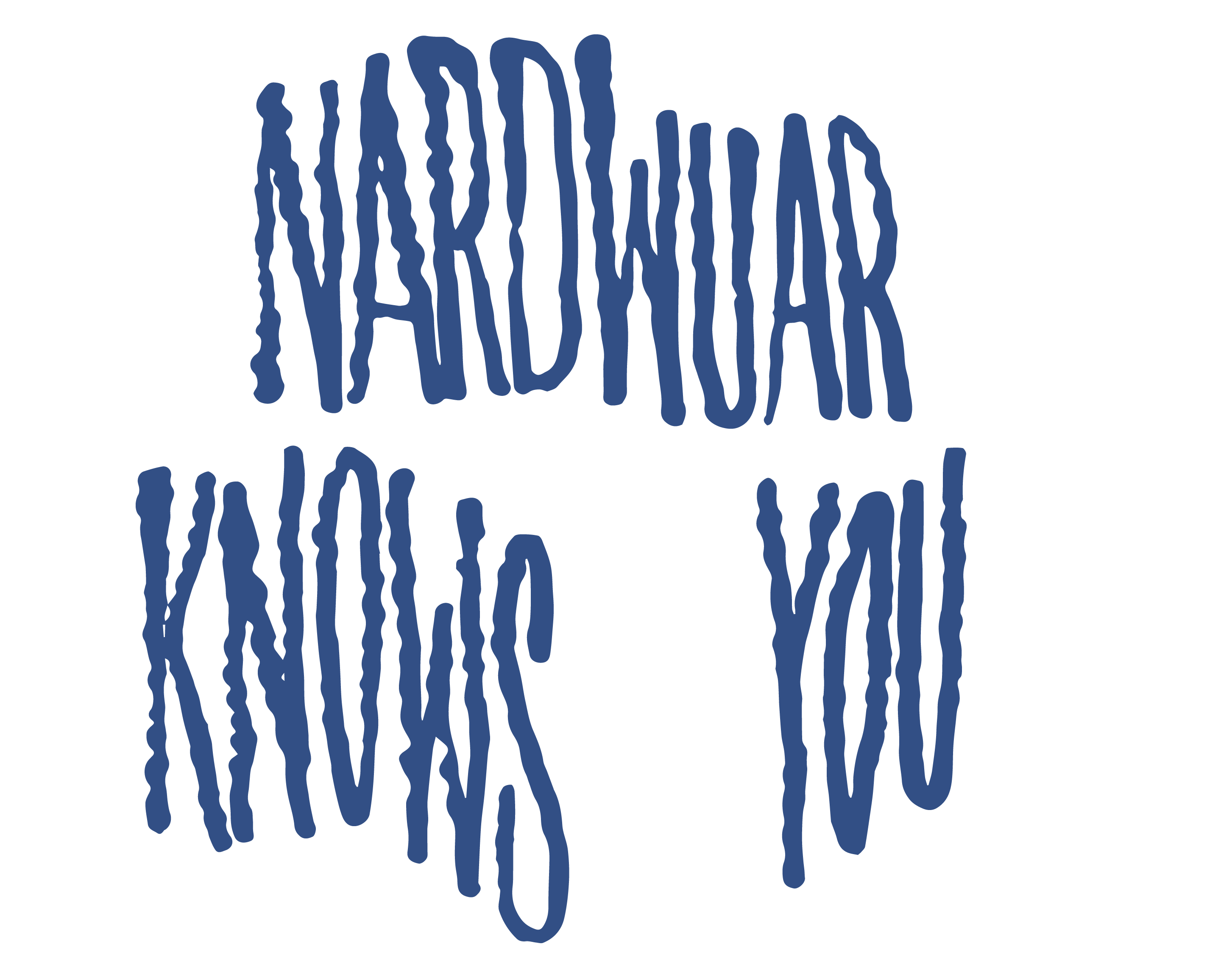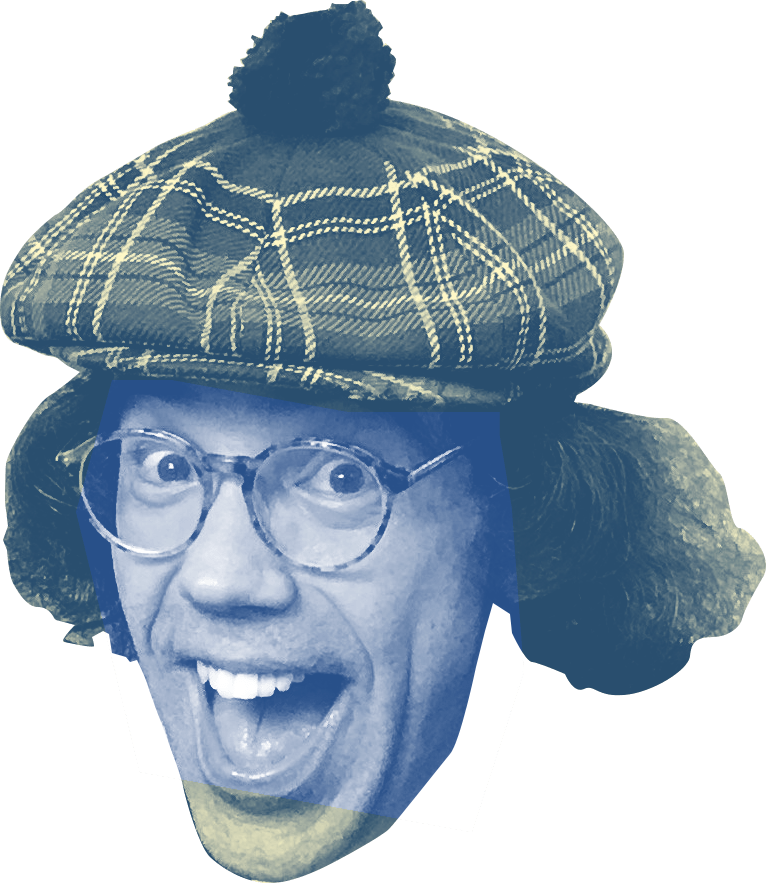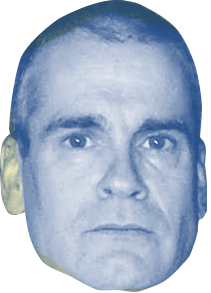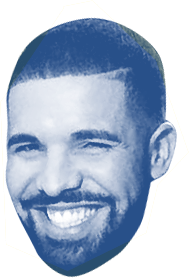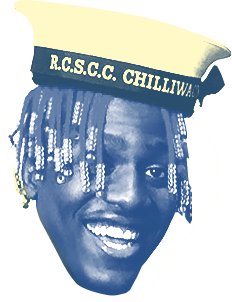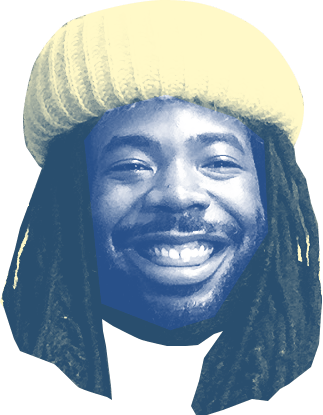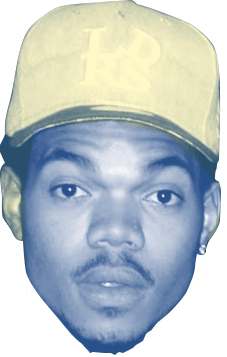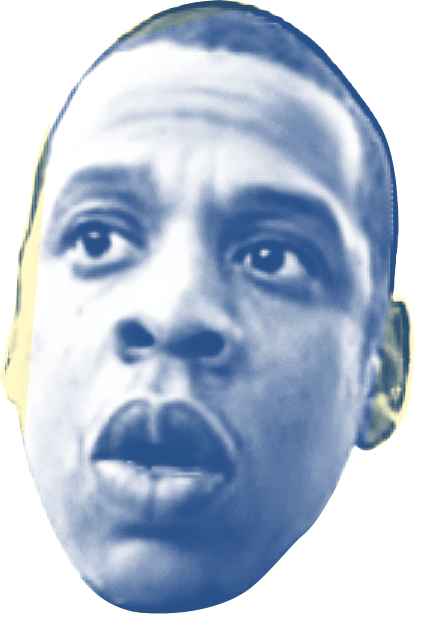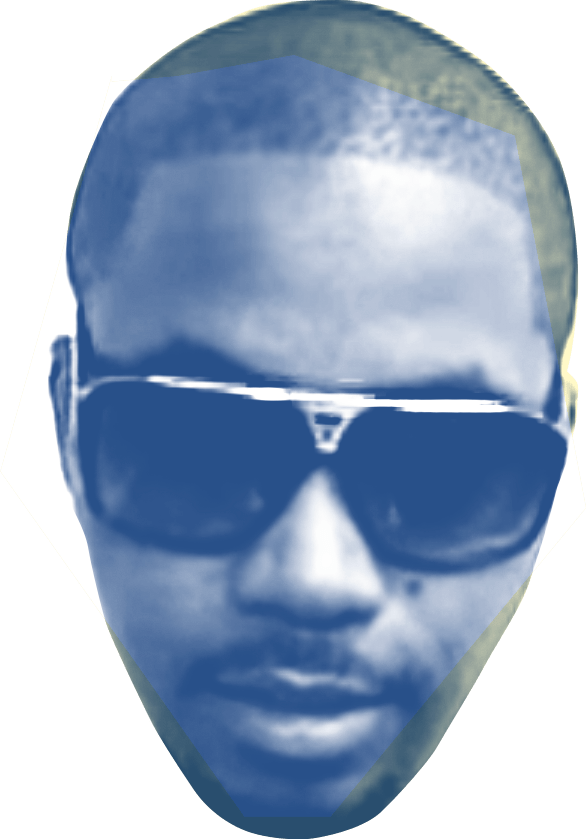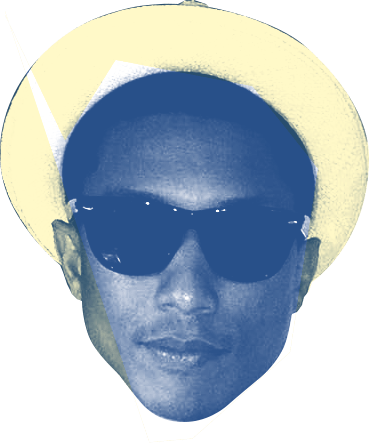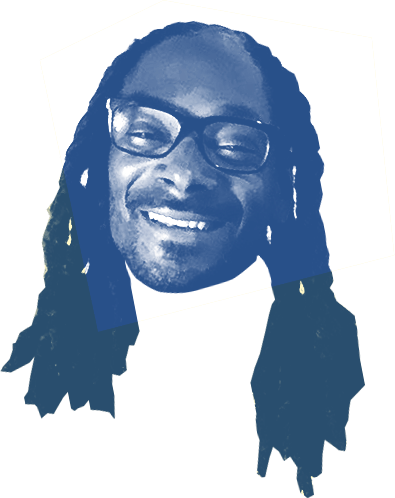Pharrell looks like he’s about to scream. The year is 2008, and he’s perched on a bench in a hotel room with floor-to-ceiling windows that look out across Vancouver. To his left is his N.E.R.D. bandmate Shay Haley, and to his right is a bespectacled Canadian man whom he is meeting for the first time. The man is holding a MuchMusic microphone — MuchMusic is Canada’s MTV — inches from Pharrell’s mouth. It might seem like a run-of-the-mill media interview, but somehow, just a few minutes in, Pharrell is cradling an assortment of pop-culture artifacts. And he’s thrilled. “Who comes to an interview and hands you Skateboarding Vancouver Style, a Mork from Ork Mork and Mindy doll, Music of the Cosmos, and a “Rump Shaker” record?” The answer: The man known as Nardwuar the Human Serviette.
Though the interview was nearly a decade ago, Nardwuar, the Canadian radio personality and interviewer extraordinaire, looks just like he does today, with a puff of brown hair popping out from under his signature Scottish Tam, tartan pants with zipper appliques, and large, wide glasses framing his eyes. Nardwuar — birth name John Ruskin — resembles a high school teacher from an ‘80s movie who has just discovered punk music and golfing. And he continues to impress Pharrell and Haley with the range of questions he asks — about an old rumor concerning their hometown skatepark in Virginia Beach, the karate studio where Pharrell took lessons as a child, and what seems to have been a nascent plan to design an N.E.R.D phone.
Nardwuar has cultivated a reputation that makes artists actually want to be interviewed by him.
“Your research is second-to-none,” Pharrell tells Nardwuar. “And I can only imagine you probably do the same kind of research with every band you interview. So, that’s pretty impressive, man.” The wacky Canadian, clearly touched, thanks Pharrell. To end the interview he offers his trademark closing phrase, “Doot doola doot doo...,” and then shoves the microphone back in front of Pharrell’s face. “Doot doo,” Pharrell says, as if speaking this strange language was second nature to him.
I first learned of Nardwuar six years ago when I saw the now-infamous (among Nardwuar fans, at least) Pharrell interview. And while I can’t remember the exact social media path that led me to his YouTube channel, I do remember being immediately hooked on it, watching a marathon of his interviews for longer than I’d like to admit — Nardwuar asking Mikhail Gorbachev which world leader wore the biggest pants, Nardwuar asking Iggy Pop about his cock, Nardwuar microwaving a blunt with Snoop Dogg. Like most people who have seen his work, I was instantly impressed by the forensic way he researches his interview subjects and the theatricality with which he approaches his weekly show, which is celebrating its 30th anniversary this year.
But after all those years of watching Nardwuar on YouTube, I was remiss in how little I knew about the man who knows so much. It was time to ask Nardwuar the questions.
Nardwuar resembles a high school teacher from an '80s movie who has just discovered punk music and golfing.
There are certain things we know for sure about Nardwuar. He was born on July 5, 1968 in Vancouver to Olga, a journalist, and Vernon, an engineer. He studied history at the University of British Columbia. He adopted the name Nardwuar in 1986, and insists it has no great meaning. In a 1995 interview with the CBC, he said that Narduwar was “a dumb stupid name, just like Sting!” In other interviews, he has said that Nardwuar was a funny-sounding word he came up with while making weird noises to himself one day. He conducted his first interview on September 26, 1985, in a classroom-turned-dressing room in Hillside Secondary School in West Vancouver, where he was a student. His obliging subjects were Art Bergmann and Tom Upex of the punk band Poisoned, still sweaty from performing at the first school dance of the year. Nardwuar, baby-faced and dressed in a plain crewneck sweatshirt, appears excited and eager to impress. “I remember one day my friend told me, he goes, “John, go buy a Young Canadians record, because if you look in the EP if you look on the inside cover it says, ‘Thanks to Hillside Secondary School,’” he says to Bergman and Upex. “I thought that was kind of neat. How come you thanked Hillside Secondary School?” The two act unimpressed and almost dismissive. “You’ll notice on the thank yous we thanked everybody in the world,” Bergmann says. At the interview’s end the band seems eager for Nardwuar to finish his goodbyes and go. They play the role of disinterested rock band as well, as young John plays the role of the teen music scene gadfly.
Nardwuar logged more than 10,000 hours of interview time before he became known to a larger audience through the internet. After airing on the Vancouver college radio station CiTR for 19 years, Nardwuar uploaded his first video to YouTube in 2006: a single-question interview from 1995 in which Dan Quayle, the former vice president of the U.S., cannot name the prime minister of Canada. It could have been what we call in our modern parlance a “viral moment” — a perfect, easily digestible soundbite prime for sharing on all one’s networks. But when Nardwuar sent the tape of the incident to various Canadian media outlets after it happened, no one picked it up.
The memory of Nardwuar’s obscure beginnings doesn’t faze him. “When I see people post on YouTube ‘Only 20 people liked my video,’ [I think] you should be damn proud,” he told me. “Because I remember my interview with Quayle, I don't think it even reached under 20 people.” Still, it can be said that Nardwuar pioneered — and perfected — the video interview format. He began doing video interviews, rather than audio-only interviews, in the early ‘90s because he found the sound was of better quality to use for his radio shows. As a result, his oeuvre includes a compendium of obscure videos: A 1994 interview with Kurt Cobain can be enjoyed by a whole new Nirvana fanbase made up of listeners who were not even alive at the same time as its legendary frontman. In a 1991 interview with Sonic Youth, Nardwuar brings the band a rare record he thinks they might like and guitarist Lee Ranaldo proceeds to heartlessly break it. And a 1999 interview with Motorhead gives a rare glimpse of one of Nardwuar’s other loves: kitschy restaurants. His YouTube channel now has more than 500,000 subscribers, and he also hosts his interviews on his website, which students from the Vancouver Film School built for him in 1996.
A survey of the 400 or so videos on Nardwuar’s channel shows a man with a talent for coaxing his subjects out from behind their public-relations masks. He does this by mentioning seemingly insignificant details from their past that might remind them of a time when they were still falling in love with music, when their passions ruled over their personas. And although Nardwuar is unfailingly charismatic, he maintains an air of mystery during his interviews, making sure that attention doesn’t linger on him too long. When Pharrell attempted to conduct his own Nardwuar-style interview on Nardwuar himself in 2013, the Human Serviette appeared as touched as he was shy.
"That’s all I’m kinda looking forward to, is meeting Neil Young and then dying a happy life.”
As an artist, having a Nardwuar interview under your belt is a sign that you’re making it in the industry. As a journalist, I was a little nervous to turn the microphone around on him. How does one interview one of the best living interviewers? But throughout our two hours on the phone earlier this month, Nardwuar tried his best convince me that he is nothing special. “If I can do it anybody can, basically,” he said. When I tell him how excited I am to speak to him he tells me how excited he is that I am asking him questions in English. “Because you speak Haitian, too, right?” I’m not fluent in Creole, I tell him, but otherwise his research skills are on point. “The ex-governor of Canada, Michaëlle Jean, was speaking Creole. And I think also 21 Savage has Haitian roots. Pretty cool,” he said. He knows where I went to college and where I used to live. He’s interested to know about Portland’s hip-hop scene and which artists I would recommend. Now feeling like a VIP, I’m more than happy to tell him.
Humble as ever, Nardwuar insists he is always learning. He credits his community at CiTR with keeping him fresh. “People just love music there. I'm not the only one that has done a show for 30 years,” he said. “It's definitely a group of people that just love music and love turning on people to music. Plus there are a lot of students. A lot of young people that turn the older guys like myself onto newer bands.” Nardwuar also has the utmost respect for the people who take the time to call into his radio show. He originally adopted his “doot doola doot doo” sign off — a reference to the song the organist would play at the end of hockey games he attended as a kid — as a way to politely acknowledge callers before cutting away from them instead of just dumping them without warning like most call-in radio shows do. But mostly he wants to keep his show interesting and relevant. “You're constantly on your toes,” he said of being on the radio. “Is somebody gonna phone in and say (he assumes the grizzled exaggerated voice of an angry caller), ‘This is boring! Stop talking! Play a tune!’ I love that. I'm constantly on alert that somebody will phone in and say that.”
Nardwuar says he learned much of his journalistic practice from his mother, Olga, who died in 2010. She was a reporter who hosted a local Vancouver show called “Our Pioneers and Neighbors,” in which she interviewed residents of the city’s North and West neighborhoods (episodes of the show, which aired in the 1970s and '80s show are available on YouTube). In Olga, you can see the basis of Nardwuar’s genuine curiosity in and enthusiasm for other people. He credits Olga with teaching him one of his most important lessons about interviewing. “She proved to me that the next door neighbor had just as interesting a story as the celebrity,” Nardwuar said. “So she installed that in me, that everybody has a story. In other words, it is the interviewer's job to make the interviewee look exciting. Afterwards you can't go and say 'oh that person was boring.' No, it is up to you to bring out the best in that person.”
Despite his sensitive and endlessly curious approach to interviewing, Nardwuar’s style doesn’t mesh with everyone he meets. “You only have like two more questions until we’re done,” Henry Rollins told Nardwuar five minutes into their 1998 interview. In a 2009 piece, Nas failed to offer the closing “Doot doo” Nardwuar requests from his subjects, instead saying, “It’s over, move the mic.”
Nardwuar’s interview technique has strengthened and standardized in subtle ways in his long career — he now rarely reveals his research sources, uses props consistently, and follows his closing line with an extended, unannounced pose for the camera — but for the most part they’re largely unvaried in form. What has changed in that time, though, is the power dynamic between artists and music journalists. Social media has created a landscape that has largely freed artists from what can be a mind-numbing commitment to repetitive promotional interviews and press conferences. But lack of access in itself hasn’t made boring celebrity interviews totally obsolete, especially as the endurance of marathon press junkets ahead of major movies proves. "In an age when everyone understands the power of PR and marketing and where they control how they spin their artists, he subverts that entire process," Nardwuar’s MuchMusic videographer told Vancouver alt-weekly Georgia Straight in 2004.
Despite Nardwuar’s successes — 30 years on the radio, a contributor gig with MuchMusic that gave him access to bigger artists, his YouTube channel, which has more than 104 million views — his efforts to break into American media went unacknowledged. Nardwuar told me that over the years he sent tapes off to places like MTV, The Late Show with David Letterman, and Late Night With Conan O’Brien, only to be met with silence or rejection. “If I [had followed] Malcolm Gladwell's motto of 10,000 hours, I wouldn't be talking to you today,” he said, referring to the journalist’s theory that one can become “world-class” in any field after 10,000 hours of studying it. In the 1995 CBC interview, Nardwuar addressed his “underground” status: “Well, I’m kinda happy at CiTR working part-time giving tours of the station. I’ve sent away tapes, but most people aren’t interested at all,” he said. “They just send it back to me. Cuz they’re just not interested in that type of stuff. But you just keep plugging away and hope sometime that you’ll be able to meet Neil Young and that you’ll be able to die. That’s all I’m kinda looking forward to, is meeting Neil Young and then dying a happy life.” (Nardwuar’s dream of interviewing Young has yet to manifest.)
Despite not being anointed as the next big thing by American media, Nardwuar’s circuitous impact on music journalism is indelible. Music publications regularly promote his interviews, and he has a worldwide network of fans waiting for his every new upload to YouTube. “When people say they like what I do, it inspires me to do more,” he said. “When people say I don't like what you do that inspires me to do more because they have an opinion. I love that.”
As our interview came to a close, Nardwuar and I chatted casually about music and our hometowns and traded recommendations of artists to check out. It wasn’t until our last words that I realized just how subtly he turned the interview around on me without my noticing. After I told him to have a nice day he said, “and doot doola doot doo...,” to which I happily replied, “doot doo.”

